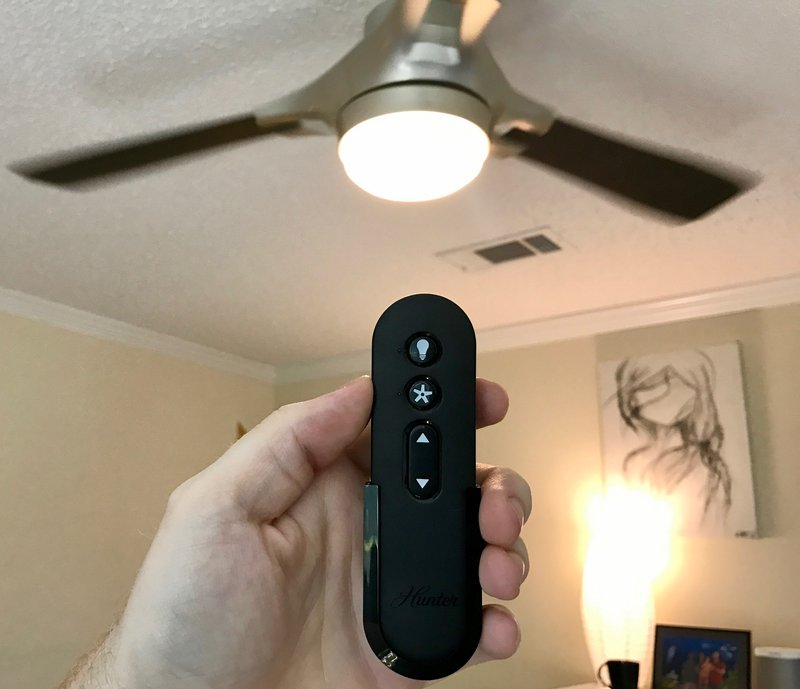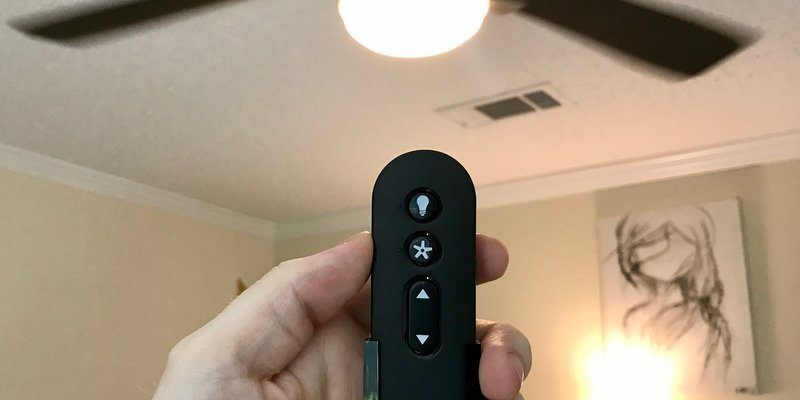
Here’s the thing: fan remotes might all look alike, but inside, they can speak very different “languages.” Some use unique codes or pairing methods, while others stick to specific frequencies. If you’ve ever lost or broken your original remote, or if you’ve moved into a place with a different brand fan, it’s natural to wonder whether you can simply swap in a Hunter remote to save the day. Before you start pressing random buttons and hoping for the best, let’s break down how these remotes work, why compatibility isn’t as easy as you’d hope, and what your actual options look like.
Understanding How Hunter Ceiling Fan Remotes Work
Let me explain how a Hunter ceiling fan remote actually communicates with its fan. The basics are simple enough: the remote sends out a wireless signal, usually via radio frequency (RF), to a receiver installed inside the fan. It’s kind of like walkie-talkies—each device needs to be on the same channel, or, in this case, frequency and code.
Most Hunter remotes and receivers are designed as a matched pair. The remote talks to the receiver using specific dip switch settings or digital codes. If you don’t have the right code, the remote is just a fancy piece of plastic. This means out of the box, a Hunter remote is “tuned in” to speak only to its designated Hunter receiver.
Here’s an example: suppose you accidentally reset your Hunter remote or swapped the batteries, and it suddenly stops syncing with your fan. That’s a hint that the *pairing process* isn’t universal—it relies heavily on precise settings that are unique to Hunter’s system.
Why Ceiling Fan Remote Compatibility Isn’t Always Possible
Now, you might be wondering: “If all ceiling fans come with receivers, can’t any remote work with any fan?” Honestly, it’s a fair question, but the answer is almost always no. Each fan maker—Hunter, Hampton Bay, Harbor Breeze, and so on—often uses its own codes and signal formats.
Hunter ceiling fan remotes are made to pair with Hunter receivers, which often have proprietary chips and programmed instructions that don’t recognize signals from other brands. Even if two remotes use the same frequency (like 304 MHz), the code structure sent over that frequency is often totally different.
Think of it like safes with combination locks. Even if two safes use the same number of digits, the correct code for one won’t open the other. If you try to sync a Hunter remote with, say, an old Harbor Breeze fan, you’ll probably just get silence—no lights, no spinning blades.
The Role of Frequencies, Codes, and Pairing
Pairing a remote to a fan isn’t just about matching frequencies. Each Hunter remote and receiver set uses a unique *code*—sometimes set with tiny dip switches inside the battery compartment, other times programmed digitally. When you press a button on your remote, it sends out a specific signal. The fan’s receiver is waiting to “hear” only its special code.
- Dip switches: Older Hunter models use a series of tiny switches you set in a specific up-down pattern to match the remote and receiver.
- Digital pairing: Newer remotes might use a “pair” or “learn” button, allowing the remote and receiver to sync automatically after a reset or battery change.
- Battery matters: Weak or mismatched batteries can make pairing fail, even if codes are correct.
If you’re hoping to use a Hunter remote with another brand, the fan’s receiver has to understand Hunter’s code. Most non-Hunter fans are simply “deaf” to it. Even with the right frequency, if the codes don’t match, nothing happens.
What About Universal Ceiling Fan Remotes?
Here’s where things get interesting. Universal ceiling fan remotes are marketed as do-it-all solutions. They come with a universal receiver you install in your fan, and a paired remote. The “universal” label really means that you’re replacing your old receiver with theirs—not that any remote can talk to any fan out of the box.
So, you could use a universal remote kit for a fan from almost any brand, but only after installing their receiver. The Hunter remote, unless it’s specifically marked as universal and comes with a new receiver, won’t magically operate fans from other brands.
Universal isn’t as universal as you think. In most cases, you’re actually swapping out the brain inside the fan so the remote has something familiar to talk to.
If convenience is your goal, this might be your best bet. But you’ll need to climb up, open the fan canopy, and do some minor wiring.
Common Troubleshooting Steps for Hunter Fan Remotes
You might be stuck with a non-working Hunter remote and are wondering if it’s a compatibility problem or just a tech hiccup. Before giving up, it’s smart to troubleshoot—sometimes it’s a quick fix.
- Reset and re-pair: Many Hunter remotes have a reset button or “pair” function. Try removing the batteries, pressing the power button for a few seconds, then reinstalling the batteries and pairing.
- Check the code: If your remote and receiver use dip switches, make sure the codes match exactly.
- Battery check: Weak batteries are a classic culprit. Try a fresh set, and confirm the batteries are installed correctly.
- Receiver reset: Some Hunter fans let you reset the receiver by flipping the wall switch off and on several times. Give it a shot before assuming the remote is incompatible.
If none of these tips work, chances are high that your remote simply can’t communicate with a non-Hunter receiver.
Real-World Examples: When Hunter Remotes Work (and When They Don’t)
Let me paint a picture. My neighbor once tried using his Hunter remote to control a fan he inherited from Uncle Jimmy—some off-brand unit from the 90s. After plenty of button-mashing, nothing worked. That’s because Uncle Jimmy’s fan had a completely different receiver. We ended up installing a universal remote kit to get things up and running—a small wiring job, but problem solved.
On the flip side, if you have two Hunter fans in different rooms, and you set both remotes and receivers to the same code, you might accidentally control both fans at once. That’s both a plus and a minus, depending on your setup.
If your Hunter remote has the same frequency and code as another Hunter receiver, it’ll work. But outside the Hunter world? It’s a long shot.
Hunter Remote Alternatives and Upgrade Paths
If your Hunter remote has died or you’re switching brands, you have a few options. First, you can almost always find Hunter replacement remotes that pair directly with Hunter receivers. But if you’re moving to a different fan brand, you’ll likely need a universal fan remote kit.
Universal kits come with a new receiver and remote. Install the receiver in your fan canopy, wire it according to the instructions, and pair it with the new remote. Now you have full control, regardless of the original brand.
- If you want smart home features, consider a smart universal kit with Wi-Fi or Bluetooth controls—just remember, you’ll need to install a new receiver.
- Remote pairing and syncing instructions are usually clear, but double-check which wire goes where. Labeling them (even with masking tape) can save headaches.
Selection Tips: Choosing the Right Remote for Your Ceiling Fan
Here’s what to look for if you’re shopping for a remote—Hunter or otherwise. Double-check model compatibility. Fan manuals often list which remotes work, or you can look for a part number on your original remote or receiver.
- Match the brand: If you have a Hunter fan, stick with Hunter remotes for the easiest pairing.
- Check the receiver type: Some fans have built-in receivers, while others use a separate module. Hunter’s documentation can usually tell you.
- Think universal if needed: If you want to mix and match brands, a universal remote kit (with new receiver) is your safest bet.
- Consider future upgrades: If you plan on adding more smart features later, choose a universal kit with smart compatibility.
Remember, not every remote labeled “universal” is truly plug-and-play. Always look for clear information about what comes in the kit—most require installing a matching receiver in your fan canopy.
Key Takeaways: Matching Hunter Remotes With Other Brands
At the end of the day, here’s the reality: a Hunter ceiling fan remote almost never works with other brands unless you install a universal receiver that’s designed to talk to the remote. The original Hunter remote is built with codes and frequencies that only “speak Hunter.” If you have a Hunter fan, finding a replacement is straightforward. For other brands, you’ll need a universal remote kit with its own receiver.
Troubleshooting is worth a shot if you’re having problems. But if your goal is cross-brand compatibility, remember—ceiling fan remotes aren’t as universal as you might hope. When in doubt, read the fan’s model details, check Hunter’s support guides, or consider a universal kit. It might save time, confusion, and a few choice words.
Ceiling fan tech isn’t always plug-and-play, but with the right info and a little patience, you’ll have control at your fingertips—no matter what brand spins above your head.
